The ideal spine is defined by an iconic “S” curvature. The curves in our spines are important because they mitigate shock, absorbing and dissipating energy to prevent that burden from falling on our joints, muscles, and bones. A spine that is unable to retain its “S” curvature is a spine that’s subject to further displacement and one that’s unsupportive of posture and physical wellness.

At Ideal Spine Health Center in Boise, ID, assessing proper spinal curvature is the premier focus of our practice. Utilizing Chiropractic BioPhysics (CBP) to quantify curvature, we’re able to discern the offset from each individual patient’s ideal spinal position. And, through tailored adjustment plans, can help them correct curvature deformities to restore balance to the spine.
Types of curvature deformities
There are three broad categorizations for spinal curvature deformities, each representing a different movement of the spine as it’s displaced from ideal on an X/Y/Z axis:
- Lordosis: A spine that curves inward in the lumbar and sacral regions shows signs of lordosis.
- Kyphosis: Often called “hunchback,” this condition causes the cervical spine to protrude outwards.
- Scoliosis: When the spine curves on the X-axis, it’s a sign of scoliosis and usually takes a “C” or “S” shape.
In each instance of displacement, the spine loses its ability to act as a shock absorber, simply because the rebounding mechanics of the spinal structure are lost. Depending on the severity of the case, targeted chiropractic adjustments can help to restore some of this balance. In some extreme cases, such as curvature deformity from birth, spinal position cannot be fully recovered.
Restoring ideal position
Using CBP to determine spinal deviation, it’s possible to plot the path back to “center” for an individual patient suffering from curvature deformities. For example, using geometric reference points to an ideal spine model, a CBP chiropractor can calculate degrees of deviation and create an adjustment plan that reverses these degrees. Mirror image adjustment can be highly effective in reversing the effects of curvature ailments.
It’s essential to take a quantitative approach to remedying spinal curvature misalignments. Adjusting without reference to the ideal spine position can create issues of overcorrection, or worse create additional shifting that hampers spinal function. For example, adding translation when attempting to remedy kyphosis compounds problems, instead of alleviating them!
To ensure your spinal curvature is being assessed and restored in the best, most appropriate way, it’s important to trust a CBP chiropractor. At Ideal Spine Health Center in Boise, ID, we work to create an encompassing profile of your curvature deviation before making any adjustments. The result can be seen in the ongoing, sustainable way we perform adjustments on each individual patient.
To learn more about how CBP could help restore your spine to its ideal posture, get in touch with us today for a free consultation. We can help pinpoint the type of deviation you’re experiencing, as well as the severity, to provide a tailored solution that best benefits your spinal health.
Chiropractic BioPhysics, or CBP, is one of the most scientific, researched, and results-oriented corrective care techniques. CBP-trained chiropractors aim to realign the spine back to health, eliminating nerve interference and addressing the source of pain, fatigue, and disease. As with all chiropractic care, CBP is gentle, painless, and non-invasive.
